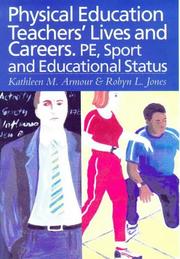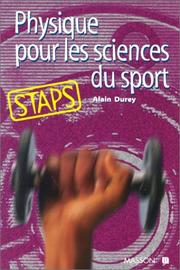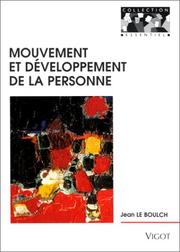| Listing 1 - 10 of 17 | << page >> |
Sort by
|
Book

ISBN: 2848677600 2848676043 Year: 2020 Publisher: Besançon : Presses universitaires de Franche-Comté,
Abstract | Keywords | Export | Availability | Bookmark
 Loading...
Loading...Choose an application
- Reference Manager
- EndNote
- RefWorks (Direct export to RefWorks)
Cet ouvrage s’attache à comprendre les modalités et les processus en jeu dans la construction des inégalités d’accès aux savoirs en EPS en croisant les regards sociologiques et didactiques. Selon les articles, la focale est mise sur les effets différentiels voire différenciateurs de la diffusion/appropriation des savoirs en fonction du type d’établissement, de la position scolaire des élèves, du genre ou du positionnement de genre et des profils des élèves, notamment ceux à besoins particuliers. Au-delà de leur spécificité, liée à l’ancrage disciplinaire et au contexte d’étude, les résultats exposés contribuent à éclairer les modalités de dépassement des inégalités d’accès aux savoirs. Ce livre s’adresse aux formateurs intervenant en formation initiale ou continue en EPS, aux chercheurs et doctorants en didactique(s) ou en sociodidactique ainsi qu’aux enseignants d’EPS ou aux étudiants se destinant au métier d’enseignant du premier ou du second degré.
Education --- savoir --- didactique --- EPS --- inégalité scolaire --- apprentissage
Book

ISBN: 2848677570 2848675640 9782848675640 Year: 2020 Publisher: Besançon : Presses universitaires de Franche-Comté,
Abstract | Keywords | Export | Availability | Bookmark
 Loading...
Loading...Choose an application
- Reference Manager
- EndNote
- RefWorks (Direct export to RefWorks)
Ce cinquième livre s’inscrit dans la continuité de nos précédents ouvrages. Configurations du jeu. Débat d’idées et apprentissage des sports collectifs, Autour du temps. Apprentissages, espaces, projets, Des signes au sens et L’intelligence tactique édités aux Presses de l’Université de Franche-Comté. Pour clore ce long chemin, il fallait bien s’intéresser aux objets techniques si souvent mis en avant dans les apprentissages. C’est, donc, la poursuite du travail collectif mené par le « Groupe de Recherche sur l’Intervention dans les Activités Physiques et Sportives » de l’Université de Franche-Comté autour de la problématique de l’enseignement des sports collectifs à l’école. Cet ouvrage s’adresse aux étudiants en STAPS, aux formateurs et professeurs d’éducation physique et sportive, aux entraîneurs ainsi qu’à tous les curieux qui s’intéressent aux sports collectifs.
Education --- apprentissage --- didactique --- sport collectif --- EPS
Book
Year: 2018 Publisher: Frontiers Media SA
Abstract | Keywords | Export | Availability | Bookmark
 Loading...
Loading...Choose an application
- Reference Manager
- EndNote
- RefWorks (Direct export to RefWorks)
Microorganisms (bacteria, archaea, microeukaryotes) in marine environments secrete a diverse array of exopolymeric substances that facilitate attachment to surfaces, the formation of organic colloids and larger aggregations of cells (marine snow), and that can influence many ocean, as well as global, processes. The aim of this Research Topic is to highlight recent advances in the sources, chemistry and function of these microbial-produced macromolecules. We encouraged original research and reviews on exopolymeric substances, from their sources, chemico-physiological properties, functions and ecosystem effects, and including their role in the Gulf of Mexico following the Deepwater Horizon oil spill disaster.
marine oil snow (MOS) --- exopolymers --- marine environment --- biological pump --- phytoplankton --- marine snow --- oceans --- marine bacteria --- exopolysaccharide substances (EPS) --- organic carbon --- marine oil snow (MOS) --- exopolymers --- marine environment --- biological pump --- phytoplankton --- marine snow --- oceans --- marine bacteria --- exopolysaccharide substances (EPS) --- organic carbon

ISBN: 0750708174 0750708182 Year: 1998 Publisher: London Falmer
Abstract | Keywords | Export | Availability | Bookmark
 Loading...
Loading...Choose an application
- Reference Manager
- EndNote
- RefWorks (Direct export to RefWorks)
Physical education and training --- Physical education teachers --- Study and teaching (Secondary) --- Case studies --- Education physique [Professeurs d' ] --- Enseignants d'éducation physique --- Gymnastiekleraars --- Gymnastique [Professeurs de ] --- Leraars lichamelijke opvoeding --- Lichamelijke opvoeding [Leraars ] --- Moniteurs d'éducation physique --- Professeurs d'EPS --- Professeurs d'éducation physique --- Professeurs de gymnastique --- Teachers [Physical education ] --- Turnleraars --- Éducateurs d'EPS --- 372.879.6 --- 372.879.6 Lichamelijke opvoeding. Didactiek van de lichamelijke opvoeding --(niet-universitair onderwijs) --- Lichamelijke opvoeding. Didactiek van de lichamelijke opvoeding --(niet-universitair onderwijs) --- Physical educators --- Teachers --- Athletic training --- Education, Physical --- P.E. (Physical education) --- PE (Physical education) --- Phy ed --- Phys ed --- Physical culture --- Physical training --- Sports --- Sports training --- Training, Physical --- Education --- Athletics --- Exercise --- Gymnastics --- Study and teaching (Secondary)&delete& --- Training --- Study and teaching --- Training of --- Case studies.
Book
Year: 2021 Publisher: Basel, Switzerland MDPI - Multidisciplinary Digital Publishing Institute
Abstract | Keywords | Export | Availability | Bookmark
 Loading...
Loading...Choose an application
- Reference Manager
- EndNote
- RefWorks (Direct export to RefWorks)
This book collects contributions to the Special Issue entitled "Symmetries in Quantum Mechanics and Statistical Physics" of the journal Symmetry. These contributions focus on recent advancements in the study of PT–invariance of non-Hermitian Hamiltonians, the supersymmetric quantum mechanics of relativistic and non-relativisitc systems, duality transformations for power–law potentials and conformal transformations. New aspects on the spreading of wave packets are also discussed.
Research & information: general --- Technology: general issues --- non-Hermitian quantum dynamics --- unitary vicinity of exceptional points --- degenerate perturbation theory --- Hilbert-space geometry near EPs --- relativistic wave equation --- Klein-Gordon equation --- Dirac equation --- Proca equation --- supersymmetry --- quantum mechanics --- shape invariance --- curved space --- position-dependent mass --- supersymmetric quantum mechanics --- self-adjoint extensions --- infinite square well --- contact potentials --- power-law duality --- classical and quantum mechanics --- semiclassical quantization --- quark confinement --- spreading wave function --- scattering --- localization --- Klein-Gordon oscillator --- Green's function --- semiclassical theories and applications --- classical general relativity --- non-Hermitian quantum dynamics --- unitary vicinity of exceptional points --- degenerate perturbation theory --- Hilbert-space geometry near EPs --- relativistic wave equation --- Klein-Gordon equation --- Dirac equation --- Proca equation --- supersymmetry --- quantum mechanics --- shape invariance --- curved space --- position-dependent mass --- supersymmetric quantum mechanics --- self-adjoint extensions --- infinite square well --- contact potentials --- power-law duality --- classical and quantum mechanics --- semiclassical quantization --- quark confinement --- spreading wave function --- scattering --- localization --- Klein-Gordon oscillator --- Green's function --- semiclassical theories and applications --- classical general relativity
Book
ISBN: 213044833X Year: 1992 Publisher: Paris : PUF - Presses Universitaires de France,
Abstract | Keywords | Export | Availability | Bookmark
 Loading...
Loading...Choose an application
- Reference Manager
- EndNote
- RefWorks (Direct export to RefWorks)
Activités physiques --- Activités physiques et sportives éducatives --- Activités sportives --- Athletic training --- Culture physique --- EPS --- Education [Physical ] --- Education physique --- Entraînement physique et sportif --- Lichamelijke opvoeding --- P.E. (Physical education) --- PE (Physical education) --- Phy ed --- Phys ed --- Physical culture --- Physical education and training --- Physical training --- Sports -- Entraînement --- Sports -- Préparation --- Sports -- Training --- Sports training --- Training [Physical ] --- Éducation physique et sportive --- Gymnastics --- Gymnastique --- Study and teaching --- Etude et enseignement

ISBN: 2225855366 9782225855368 Year: 1997 Volume: *7 Publisher: Paris : Masson,
Abstract | Keywords | Export | Availability | Bookmark
 Loading...
Loading...Choose an application
- Reference Manager
- EndNote
- RefWorks (Direct export to RefWorks)
Activités physiques --- Activités physiques et sportives éducatives --- Activités sportives --- Athletic training --- Body mechanics [Human ] --- Culture physique --- EPS --- Education [Physical ] --- Education physique --- Entraînement physique et sportif --- Human mecanics --- Human movements --- Lichamelijke opvoeding --- Mechaniek [Menselijke ] --- Menselijke mechaniek --- Movements [Human ] --- Mécanique humaine --- P.E. (Physical education) --- PE (Physical education) --- Phy ed --- Phys ed --- Physical culture --- Physical education and training --- Physical training --- Sports -- Entraînement --- Sports -- Préparation --- Sports -- Training --- Sports training --- Training [Physical ] --- Éducation physique et sportive --- Physique. --- Sports. --- Sports --- Mouvement --- Aspect physiologique --- Movement --- Modèle --- Models --- Activité physique --- physical activity --- Recherche --- research --- Motion --- Measurement --- Sports - Aspect physiologique

ISBN: 2711419916 9782711419913 Year: 1995 Volume: *4 Publisher: Paris : Vigot,
Abstract | Keywords | Export | Availability | Bookmark
 Loading...
Loading...Choose an application
- Reference Manager
- EndNote
- RefWorks (Direct export to RefWorks)
En suivant la chronologie du développement depuis ses fondements biologiques jusqu'à sa signification sociale, l'auteur met en évidence l'importance de l'harmonisation : d'une part, entre les deux versants de la psychomotricité l'un lié à l'émotivité, l'autre à l'adaptabilité; et d'autre part, entre la psychomotricité et son prolongement instrumental, le mouvement et la cognitivité qui s'exprime par le langage; enfin, entre la psychomotricité comme méthodologie de l'apprentissage moteur et les exigences du savoir-faire qu'impose la vie sociale
Activités physiques --- Activités physiques et sportives éducatives --- Activités sportives --- Athletic training --- Bewegingstherapie --- Culture physique --- Développement moteur --- Développement psychomoteur --- EPS --- Education [Movement ] --- Education [Physical ] --- Education physique --- Education psychomotrice --- Entraînement physique et sportif --- Lichamelijke opvoeding --- Motor psychology --- Mouvement [Thérapie par le ] --- Movement [Psychology of ] --- Movement education --- Movement therapy --- P.E. (Physical education) --- PE (Physical education) --- Phy ed --- Phys ed --- Physical culture --- Physical education and training --- Physical training --- Psycho-socio-motricité --- Psychocinétique --- Psychomotor education --- Psychomotor therapy --- Psychomotoriek --- Psychomotorishe opvoeding --- Psychomotricité --- Rééducation psychomotrice --- Socio-motricité --- Sports -- Entraînement --- Sports -- Préparation --- Sports -- Training --- Sports training --- Therapie [Bewegings] --- Thérapie par le mouvement --- Thérapie psychomotrice --- Training [Physical ] --- Éducation corporelle --- Éducation motrice --- Éducation par le mouvement --- Éducation physique et sportive --- Éducation rythmique --- Activité motrice. --- Apprentissage moteur. --- Sports --- Éducation physique et sportive. --- Psychomotricité. --- Enfants --- Mouvement. --- Performance psychomotrice. --- Développement humain. --- Éducation physique et entraînement physique. --- Anthropologie. --- Développement. --- Activité motrice. --- Éducation physique et sportive. --- Psychomotricité. --- Développement.
Book
Year: 2021 Publisher: Basel, Switzerland MDPI - Multidisciplinary Digital Publishing Institute
Abstract | Keywords | Export | Availability | Bookmark
 Loading...
Loading...Choose an application
- Reference Manager
- EndNote
- RefWorks (Direct export to RefWorks)
Over the last few decades, the study of microbial biofilms has been gaining interest among the scientific community. These microbial communities comprise cells adhered to surfaces that are surrounded by a self-produced exopolymeric matrix that protects biofilm cells against different external stresses. Biofilms can have a negative impact on different sectors within society, namely in agriculture, food industries, and veterinary and human health. As a consequence of their metabolic state and matrix protection, biofilm cells are very difficult to tackle with antibiotics or chemical disinfectants. Due to this problem, recent advances in the development of antibiotic alternatives or complementary strategies to prevent or control biofilms have been reported. This book includes different strategies to prevent biofilm formation or to control biofilm development and includes full research articles, reviews, a communication, and a perspective.
Technology: general issues --- antibiofilm --- antimicrobial agent --- bacteria --- fungi --- polymicrobial biofilm --- microalga --- free fatty acids --- encapsulation --- biofilm --- chronic wounds --- host response --- S100A8/A9 --- dental plaque --- quorum sensing --- microbial resistance --- bacterial adhesion --- blocking effect --- hydrodynamics --- parallel plate flow cell --- carbon nanotubes --- poly(dimethylsiloxane) --- adhesion --- Escherichia coli --- Biofilm --- Public Engagement --- Outreach --- Control Strategies --- Oral Biofilm --- TiO2 nanofibers --- electrospinning --- biofilm prevention and control --- multidrug-resistant bacteria --- biomedical application --- biofilms --- biofilm inhibition --- dental implants --- peri-implantitis --- polyether-ether-ketone --- Pseudomonas aeruginosa --- Candida albicans --- mixed-species biofilm analysis --- flow cytometry --- bacteriophage therapy --- prosthesis related infections --- hardware infections --- left ventricular assist devices --- Acinetobacter baumannii --- antibiotic resistance --- antibiotic tolerance --- persister --- intraspecies community --- EPS matrix --- peptide nucleic acid-fluorescence in situ hybridization --- urinary tract infections --- catheter-associated urinary tract infections --- confocal laser scanning microscopy --- recalcitrance --- biofilm control --- Klebsiella pneumoniae --- KPC and OXA-48-like carbapenemases --- Galleria mellonella infection model --- linear oligoethyleneimine hydrochloride --- bacteriophage --- endotracheal tube --- antibiofilm --- antimicrobial agent --- bacteria --- fungi --- polymicrobial biofilm --- microalga --- free fatty acids --- encapsulation --- biofilm --- chronic wounds --- host response --- S100A8/A9 --- dental plaque --- quorum sensing --- microbial resistance --- bacterial adhesion --- blocking effect --- hydrodynamics --- parallel plate flow cell --- carbon nanotubes --- poly(dimethylsiloxane) --- adhesion --- Escherichia coli --- Biofilm --- Public Engagement --- Outreach --- Control Strategies --- Oral Biofilm --- TiO2 nanofibers --- electrospinning --- biofilm prevention and control --- multidrug-resistant bacteria --- biomedical application --- biofilms --- biofilm inhibition --- dental implants --- peri-implantitis --- polyether-ether-ketone --- Pseudomonas aeruginosa --- Candida albicans --- mixed-species biofilm analysis --- flow cytometry --- bacteriophage therapy --- prosthesis related infections --- hardware infections --- left ventricular assist devices --- Acinetobacter baumannii --- antibiotic resistance --- antibiotic tolerance --- persister --- intraspecies community --- EPS matrix --- peptide nucleic acid-fluorescence in situ hybridization --- urinary tract infections --- catheter-associated urinary tract infections --- confocal laser scanning microscopy --- recalcitrance --- biofilm control --- Klebsiella pneumoniae --- KPC and OXA-48-like carbapenemases --- Galleria mellonella infection model --- linear oligoethyleneimine hydrochloride --- bacteriophage --- endotracheal tube
Book
ISBN: 3036553169 3036553150 Year: 2022 Publisher: MDPI - Multidisciplinary Digital Publishing Institute
Abstract | Keywords | Export | Availability | Bookmark
 Loading...
Loading...Choose an application
- Reference Manager
- EndNote
- RefWorks (Direct export to RefWorks)
In recent decades, the environmental impact of organic pollutants, especially persistent and emerging organic pollutants, has attracted widespread attention, and related research has been rapidly developed. Organic pollutants represent a popular topic of research in the environmental field. Large amounts of organic pollutants, which are widely distributed in air, water, sediment, soil, and other environmental media, are created via industrial production and other human activities. A series of research projects have been carried out regarding the development of analytical methods for organic pollutants, the distribution of environmental media, environmental concentration, environmental fate, the exploration of new pollutants, and the non-target analysis of organic pollutants.
Technology: general issues --- Chemical engineering --- regulated e-waste recycling --- polybrominated diphenyl ethers (PBDEs) --- heavy metals --- environmental media --- vegetable --- risks --- cardiovascular diseases (CVDs) --- heart failure --- polycyclic aromatic hydrocarbons (PAHs) --- trace elements --- serum --- polyhaloaromatic compounds --- chemiluminescence --- analytical method --- Fenton system --- hydroxyl radicals --- bisphenol analogues --- zebrafish --- joint toxicity --- gene expression --- online monitoring --- diagnosis --- PCDD/F --- incineration --- feedback control --- volatile organic compounds (VOCs) --- reference materials (RMs) --- quality control (QC) --- water analysis --- resin --- adsorption --- pore size distribution --- chemical modification --- water treatment --- PCNs --- spatial distribution --- congener --- environmental risk --- sediment --- VOCs --- distribution --- risk assessment --- chemical industrial park --- phthalate --- dietary intake --- DEHP --- DBP --- DIBP --- bottled drink --- PFASs --- QSAR–ICE–SSD --- electroplating industry --- ecological risk assessment --- PAHs --- historical trends --- shallow lake --- economic parameters --- sources --- sediment core --- gas chromatography-mass spectrometry --- HBCD --- EPS --- XPS --- POPs --- tetrabromobisphenol A --- Xenopus laevis --- brain development --- thyroid hormone --- biphasic concentration-response --- composting --- turning frequency --- ammonia oxidizing bacterial --- ammonia oxidizing archaeal --- N fractions --- ammonia emission --- screening assay --- thibz gene --- multiwell plate --- biomass combustion --- CHP plant --- renewable energies --- emission --- organic pollutants --- bisphenol analogs --- oxidative stress --- dechlorane plus --- maternal blood --- sequential samples --- variation --- correlation --- bisphenol A --- emissions --- polypropylene --- bottom sediments --- environmental monitoring --- Odra River estuary --- organotin compounds --- trueness --- verification
| Listing 1 - 10 of 17 | << page >> |
Sort by
|

 Search
Search Feedback
Feedback About UniCat
About UniCat  Help
Help News
News